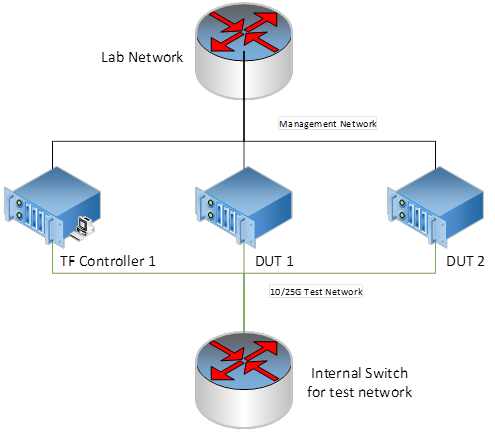performance_test_suite_v1.docx
Purpose
This document is target to define a performance test suite for Tungsten Fabric. A unified and simplified performance test solution/methodology benefits to users for
- Quickly measure the Tungsten Fabric performance by simply environment without and hardware tools/instruments dependency
- Use this test suite as a performance unified checking tool, if you do some performance optimization
- Align the performance checking methodology between developers and maintainers, for patch merging criteria
General
Hardware requirements
1x Intel Xeon server as TF Controller 1
- E.g. Intel® Xeon® Processor E5-2699 v4 +
- 256GB RAM
- 1TB HDD
- 10G/25G/40G Network Interface Controller on NUMA 0
2x Intel Xeon server as TF DUT1 and DUT2
- E.g. Intel® Xeon® Processor E5-2699 v4 +
- 128GB RAM
- 1TB HDD
- 10G/25G/40G Network Interface Controller on NUMA 0
1x internal switch for test network
- Support the bandwidth you want to test 10G/25G/40G
- Optional, if you want to test bonding NIC, switch should support bonding feature, like LACP mode
Software Requirements
BIOS:
- Disable Turbo boost
- Power management is set to “Performance”
- Enable C0/C1
OS: Centos7.5 Minimal
Kernel parameters for isolate cores for testing. E.g.
isolcpus=10-27,38-55,66-83,94-111 nohz_full=10-27,38-55,66-83,94-111 rcu_nocbs=10-27,38-55,66-83,94-111 irqbalance=off mce=ignore_ce intel_pstate=disable iommu=pt intel_iommu=on |
Physical Network Topology for testing
Generally, the physical topology has 2 networks, 1 network is for management and the other network is for test.
Tungsten Fabric Setup
Setup a 3-node Tungsten Fabric environment is fully automated, the playbooks are at https://github.com/Juniper/contrail-ansible-deployer. Please follow up the guide to setup the Tungsten Fabric system. We use OpenStack as the orchestration for test.
The Reference of instance.yaml for 3-node setup
# copy this file to contrail-ansible-deployer/config
provider_config: bms: ssh_pwd: tester ssh_user: root ntpserver: ntp.ubuntu.com domainsuffix: sh.intel.com
instances: bms1: provider: bms ip: 10.67.111.103 roles: openstack: config_database: config: control: analytics_database: analytics: webui: openstack_compute: vrouter: PHYSICAL_INTERFACE: ens802f0 CPU_CORE_MASK: "0xff0" DPDK_UIO_DRIVER: igb_uio HUGE_PAGES: 3000 AGENT_MODE: dpdk bms2: provider: bms ip: 10.67.111.101 roles: openstack_compute: vrouter: PHYSICAL_INTERFACE: enp24s0f0 CPU_CORE_MASK: "0xff0" DPDK_UIO_DRIVER: igb_uio HUGE_PAGES: 10240 AGENT_MODE: dpdk bms3: provider: bms ip: 10.67.111.102 roles: openstack_compute: vrouter: PHYSICAL_INTERFACE: enp24s0f0 CPU_CORE_MASK: "0xff0" DPDK_UIO_DRIVER: igb_uio HUGE_PAGES: 10240 AGENT_MODE: dpdk
contrail_configuration: CLOUD_ORCHESTRATOR: openstack CONTRAIL_VERSION: 5.0.0-0.40-ocata CONTROL_DATA_NET_LIST: 192.168.1.0/24 KEYSTONE_AUTH_HOST: 192.168.1.105 KEYSTONE_AUTH_ADMIN_PASSWORD: c0ntrail123 RABBITMQ_NODE_PORT: 5673 KEYSTONE_AUTH_URL_VERSION: /v3 IPFABRIC_SERVICE_IP: 192.168.1.105 VROUTER_GATEWAY: 192.168.1.100 HTTP_PROXY: "<if you have proxy>" HTTPS_PROXY: "<if you have proxy>" NO_PROXY: "<if you have proxy>" DPDK_UIO_DRIVER: "igb_uio"
# 10.67.111.200 should be a ip address is not used. try to ping it, before you set it kolla_config: kolla_globals: kolla_internal_vip_address: 192.168.1.105 kolla_external_vip_address: 10.67.111.200 contrail_api_interface_address: 192.168.1.103 keepalived_virtual_router_id: "235" enable_haproxy: "yes" enable_ironic: "no" enable_swift: "no" kolla_passwords: keystone_admin_password: c0ntrail123
|
After deployment successful, the topology of network and services looks like,
